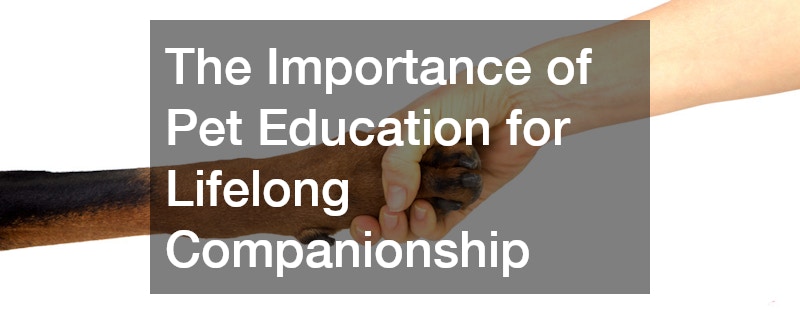Longevity Pet Care
Pet education plays a vital role in fostering a lifelong companionship between humans and their beloved animals. It is not just about training pets to obey commands or perform tricks; rather, it encompasses a comprehensive approach that focuses on their overall well-being. By investing time and effort into pet education, pet owners can build strong, trustful relationships with their animals that enhance communication and create a positive living environment for both. From early socialization to continuous mental stimulation, the principles of pet education ensure that pets grow into well-adjusted and healthy companions. The key to a successful bond often lies in understanding the unique needs of each pet and ensuring that those needs are met consistently throughout their lives.

Understanding Pet Education for Lifelong Companionship
Pet education is foundational in fostering a deep and lasting bond with a pet. When pet owners engage in consistent and thoughtful education, it strengthens the emotional connection between them and their pets, ensuring that both parties benefit from a harmonious relationship. Education covers not only behavioral training but also aspects of care such as health, diet, and mental well-being. It is about teaching pets how to navigate the world safely and comfortably while ensuring that their needs are met lovingly and responsibly. Through education, pets learn to trust their owners, and that trust is essential for lifelong, fulfilling companionship.
An important component of pet education includes providing proper nutrition, which is essential for maintaining a pet’s health and longevity. For example, a well-balanced diet of healthy dog food supports a pet’s physical development and can prevent many common health issues. Incorporating education around feeding routines and making informed dietary choices is as important as teaching pets how to behave or respond to commands. Through proper pet education, owners can ensure that their pets receive the best care possible, which strengthens the bond they share and promotes a long, happy life together.
The Role of Early Training in Pet Development
Early training is one of the most important stages in a pet’s life, as it sets the foundation for all future behaviors and interactions. By starting education at an early age, pet owners can guide their pets through key developmental stages, helping them learn appropriate social behaviors and build a sense of security. Early training is not limited to commands like “sit” or “stay”; it also involves teaching pets how to interact with people, other animals, and their environment. This foundational learning helps ensure that pets grow up well-adjusted, confident, and able to cope with the various challenges they will encounter throughout their lives. The role of early training cannot be overstated, as it shapes the pet’s entire future.
Along with early behavioral education, proper grooming practices should be introduced during the initial stages of a pet’s life. Familiarizing a pet with a regular pet grooming service helps them become comfortable with grooming routines that will be essential for their health and hygiene as they age. Teaching pets to accept and enjoy grooming from an early age reduces stress during these experiences and prevents health issues related to neglect of fur, skin, and nails. Early training combined with services like grooming ensures a well-rounded development, further cementing the pet’s ability to lead a happy and healthy life.

Building Trust Through Consistent Education
Trust is one of the most important aspects of the relationship between a pet and its owner, and consistent education is key to building that trust. Pet education involves teaching pets boundaries, acceptable behaviors, and ways to interact with the world around them. When pet owners consistently reinforce these teachings, their pets learn what to expect and feel secure in their environment. This consistency not only fosters trust but also reduces anxiety and confusion in pets, as they are given clear guidance on what is expected of them. Trust built through education creates a stronger bond, making both pet and owner more confident and comfortable in their daily interactions.
One way to enhance this trust is by integrating pet-friendly environments into their daily lives, such as creating outdoor spaces that encourage safe play and exploration. For example, utilizing an artificial grass company to install synthetic turf in a backyard provides a durable, low-maintenance area where pets can play freely without the risk of pesticides or harsh chemicals. Consistently teaching pets how to behave in outdoor environments, along with providing them with safe and reliable spaces, further strengthens the trust between owner and pet. When pets know that their needs are being met in all aspects of their lives, their trust in their owners deepens.
Socialization as a Key Component of Pet Education
Socialization is a critical component of pet education, especially during the early stages of a pet’s life. Introducing pets to a variety of experiences, people, and other animals helps them develop the necessary social skills to interact appropriately in different environments. Socialization teaches pets how to respond to new stimuli without fear or aggression, making them more adaptable and well-rounded. Through careful and controlled exposure, pet owners can help their pets build positive associations with various social situations, which is essential for reducing anxiety and preventing behavioral issues in the future. Proper socialization ensures that pets can navigate the world confidently and without unnecessary stress.
Creating a safe and secure environment for socialization is also important, particularly when it comes to outdoor interactions. For instance, aluminum fence installation around the yard provides a secure space where pets can interact with their surroundings and other animals without the risk of running into danger. This environment allows pet owners to safely expose their pets to new experiences while still maintaining control over the situation.

Reinforcement of Positive Behaviors for Better Bonding
Reinforcing positive behaviors is one of the most effective ways to strengthen the bond between a pet and its owner. Positive reinforcement involves rewarding pets for desirable behaviors, such as following commands, behaving calmly in social situations, or responding well to training. This method of education encourages pets to repeat those behaviors in the future, as they associate them with positive outcomes like treats, praise, or playtime. By focusing on positive reinforcement, pet owners can effectively shape their pets’ behaviors in a way that promotes a harmonious living environment and deepens the bond between them.
Part of maintaining positive behaviors in pets is ensuring that they are protected from negative or disruptive influences. Wildlife exclusion, for instance, can be an important factor in preventing pets from interacting with potentially harmful animals or disrupting their training routines. By minimizing distractions and risks posed by wildlife, pet owners can maintain a controlled environment that fosters continuous positive reinforcement.
Addressing Behavioral Challenges Through Education
Addressing behavioral challenges is an integral part of pet education, as it ensures that pets can live harmoniously within their homes. Many pets exhibit behaviors such as excessive barking, chewing, or jumping, which can disrupt daily life and strain the relationship between the pet and owner. Through a thoughtful approach to education, owners can identify the root causes of these behaviors and apply appropriate training techniques to correct them. Whether it involves redirecting a pet’s energy, desensitizing them to certain triggers, or teaching alternative behaviors, education is the key to overcoming these challenges and creating a peaceful home environment.
In addition to behavioral education, creating a pet-friendly home environment can support efforts to address these challenges. For instance, installing durable hardwood flooring can help mitigate damage from accidents or scratching, allowing pet owners to focus on behavioral education without worrying about constant repairs. By combining a proactive approach to addressing behavioral issues with the right environmental considerations, pet owners can create a more manageable and supportive space for both themselves and their pets.

Pet Education for Enhanced Communication
Effective communication is the foundation of a successful relationship between pets and their owners, and pet education plays a vital role in enhancing that communication. Through education, pets learn to understand verbal cues, body language, and signals from their owners, which helps bridge the gap between human and animal interaction. Similarly, owners learn how to better interpret their pets’ behaviors and needs, creating a more intuitive and responsive relationship. This two-way communication fosters a stronger bond and ensures that both the pet and owner are more in tune with each other’s needs. The result is a more cooperative and harmonious living environment.
Enhancing communication also involves organizing the home environment in ways that support the pet’s understanding of boundaries and expectations. For example, teaching a pet to respect spaces like a specific cabinet where their food or toys are stored can be part of their overall education. This reinforces not only commands but also instills a sense of structure in their daily routines.
Promoting Mental Stimulation in Pets
Mental stimulation is a crucial aspect of pet education, as it keeps pets engaged, happy, and mentally healthy. Just like humans, pets need ongoing cognitive challenges to prevent boredom and promote overall well-being. Incorporating activities such as puzzle toys, interactive play, and problem-solving exercises into a pet’s education helps keep their minds sharp and prevents the development of negative behaviors born from frustration or lack of stimulation. Consistently challenging a pet’s mind is an essential part of their lifelong education, ensuring that they remain mentally active and fulfilled.
In addition to everyday mental stimulation, pet owners must be prepared to address emergencies that may arise from overexertion or unexpected health issues. Having access to an emergency veterinary service is vital for addressing any urgent health concerns that may affect a pet’s well-being. Ensuring that a pet’s mental and physical health is supported through both education and proper care enables pet owners to provide a well-rounded, enriched life for their animals.
The Impact of Lifelong Learning on Pet Well-Being
Lifelong learning is an essential element of maintaining a pet’s overall well-being. As pets age, their needs change, and continued education helps them adapt to new physical limitations, environments, and routines. Lifelong learning keeps pets engaged and responsive to their surroundings, ensuring they remain active participants in their lives. This ongoing education is beneficial not only for mental stimulation but also for maintaining physical health. By keeping pets mentally and physically engaged through all stages of their lives, owners can help extend their pets’ quality of life and promote their overall well-being.
Providing a safe and enriching environment supports lifelong learning for pets. For example, ensuring that outdoor areas are well-maintained through regular tree pruning can create safe spaces for pets to explore and play. When outdoor areas are free from hazards such as falling branches, pets can safely continue their exploration and engagement with the environment throughout their lives.
Creating a Strong Human-Pet Relationship Through Education
The relationship between humans and their pets thrives on continuous learning and mutual respect, both of which are fostered through education. Teaching pets how to behave, respond to cues, and navigate various environments helps establish a foundation of trust and communication that strengthens the bond between pet and owner. As pets continue to learn and adapt, they become more responsive and attuned to their owner’s needs, creating a more fulfilling and harmonious relationship. This connection, built on a foundation of education, promotes a deep sense of companionship that lasts a lifetime.
In addition to fostering this bond through education, pet owners can create a comfortable and supportive environment for their pets. For instance, choosing pet-friendly materials from a local carpet store can provide a cozy and durable space where pets feel secure and at home. Just as education enhances the emotional connection between pet and owner, a well-thought-out living space contributes to the overall comfort and happiness of the pet.
Fostering Pet Relationships
Pet education is an ongoing journey that forms the backbone of lifelong companionship between humans and their pets. It encompasses everything from basic obedience and behavioral training to mental stimulation, socialization, and health considerations. Through consistent education, pets learn to trust their owners, adapt to their environments, and develop strong emotional bonds that enhance their quality of life. The more engaged pet owners are in their pets’ education, the stronger their relationship will be, benefiting both the pet’s well-being and the owner’s experience of companionship.







